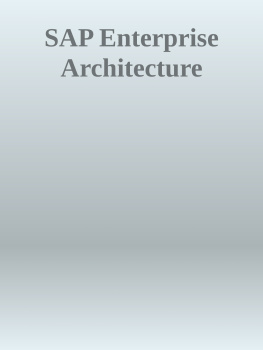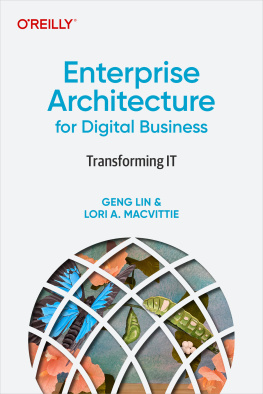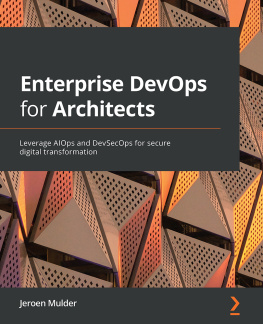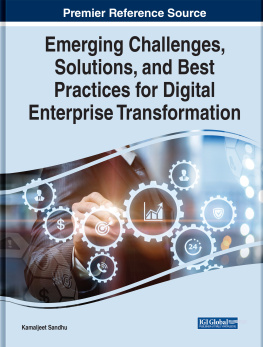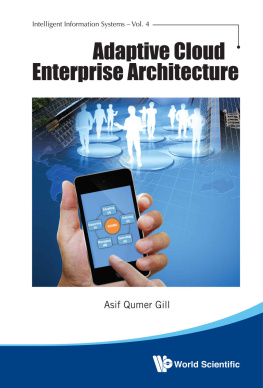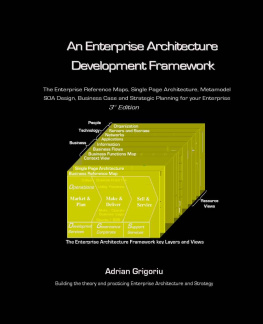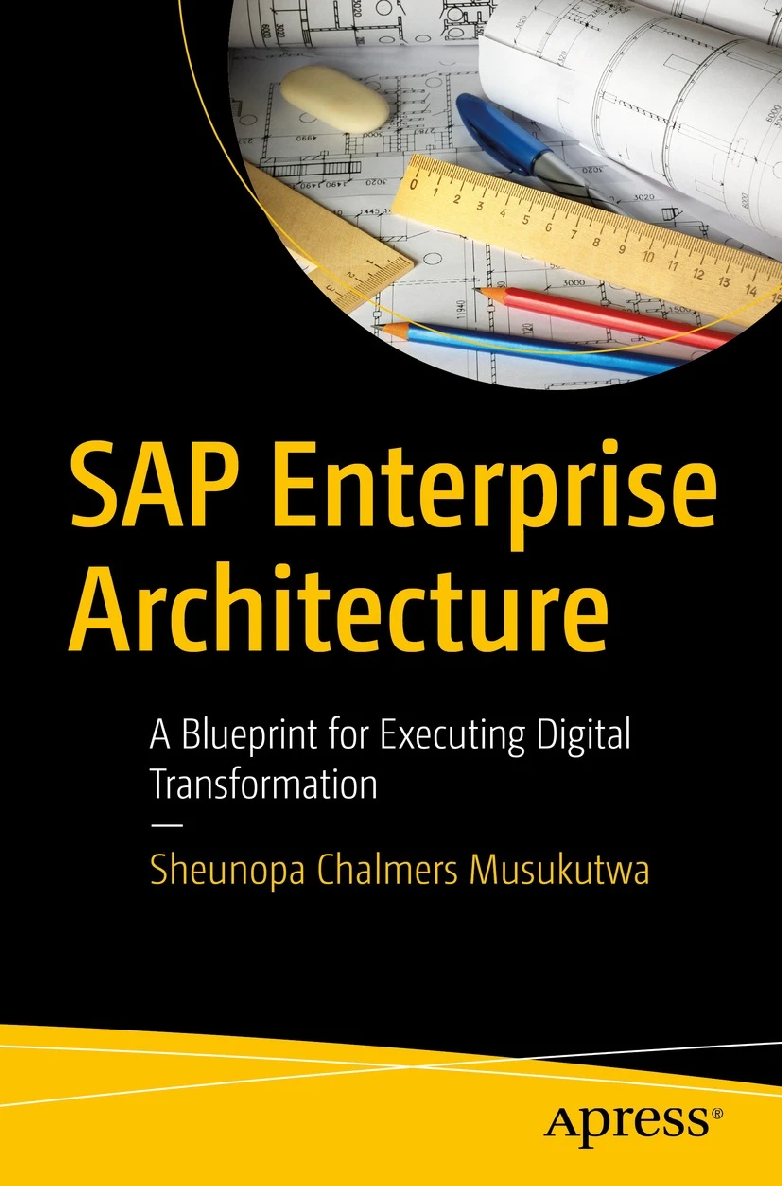
SAP Enterprise
Architecture
A Blueprint for Executing
Digital Transformation
Sheunopa Chalmers Musukutwa
SAP Enterprise Architecture: A Blueprint for Executing Digital
Transformation
Sheunopa Chalmers Musukutwa
Johannesburg, South Africa
ISBN-13 (pbk): 978-1-4842-8574-9
ISBN-13 (electronic): 978-1-4842-8575-6
https://doi.org/10.1007/978-1-4842-8575-6
Copyright 2022 by Sheunopa Chalmers Musukutwa
This work is subject to copyright. All rights are reserved by the Publisher, whether the whole or part of the material is concerned, specifically the rights of translation, reprinting, reuse of illustrations, recitation, broadcasting, reproduction on microfilms or in any other physical way, and transmission or information storage and retrieval, electronic adaptation, computer software, or by similar or dissimilar methodology now known or hereafter developed.
Trademarked names, logos, and images may appear in this book. Rather than use a trademark symbol with every occurrence of a trademarked name, logo, or image we use the names, logos, and images only in an editorial fashion and to the benefit of the trademark owner, with no intention of infringement of the trademark.
The use in this publication of trade names, trademarks, service marks, and similar terms, even if they are not identified as such, is not to be taken as an expression of opinion as to whether or not they are subject to proprietary rights.
While the advice and information in this book are believed to be true and accurate at the date of publication, neither the authors nor the editors nor the publisher can accept any legal responsibility for any errors or omissions that may be made. The publisher makes no warranty, express or implied, with respect to the material contained herein.
Managing Director, Apress Media LLC: Welmoed Spahr
Acquisitions Editor: Divya Modi
Development Editor: Laura Berendson
Coordinating Editor: Divya Modi
Cover designed by eStudioCalamar
Cover image designed by Pixabay
Distributed to the book trade worldwide by Springer Science+Business Media New York, 1
New York Plaza, Suite 4600, New York, NY 10004-1562, USA. Phone 1-800-SPRINGER, fax (201) 348-4505, e-mail orders-ny@springer-sbm.com, or visit www.springeronline.com. Apress Media, LLC is a California LLC and the sole member (owner) is Springer Science + Business Media Finance Inc (SSBM Finance Inc). SSBM Finance Inc is a Delaware corporation.
For information on translations, please e-mail booktranslations@springernature.com; for reprint, paperback, or audio rights, please e-mail bookpermissions@springernature.com.
Apress titles may be purchased in bulk for academic, corporate, or promotional use. eBook versions and licenses are also available for most titles. For more information, reference our Print and eBook Bulk Sales web page at http://www.apress.com/bulk-sales.
Any source code or other supplementary material referenced by the author in this book is available to readers on GitHub via the books product page, located at www.apress.com/.
For more detailed information, please visit http://www.apress.com/source-code.
Printed on acid-free paper
This book is dedicated to the Musukutwa Clanand especially dedicated to Judith, Sheanesu,
Jeremy, Annan and Aretha.
Table of Contents
About the Author xi About the Technical Reviewer xiii Acknowledgments xv Introduction xvii Chapter 1: Introducing Enterprise Architecture 1
Defining Enterprise Architecture 4
What Is an Enterprise? 6
What Is an Architecture? 7
The Big Picture 8
Core Elements 10
Summary24
Chapter 2: Strategic Enterprise Architecture 25
Alignment 25
Understanding the Role of Business Strategy in Enterprise Architecture 27
Business Strategy, Business Capabilities, and IT Capabilities 30
The Role of the Enterprise Architect in IT and Business Alignment 35
How to Approach IT and Business Alignment 38
Typical Alignment Scenarios 40
Closing Points on IT and Business Alignment 42
Alignment Beyond Business Strategy 43
v
Table of ConTenTs
Developing a Business Case 44
Revisiting the Four Enterprise Domains 47
Summary48
Chapter 3: Developing an Enterprise Architecture 51
The Enterprise Architecture Framework 52
The Framework 54
The People 54
The Framework 55
Architecture Domains 55
Standards 57
View Model 58
The Open Group Architecture Framework (TOGAF) 62
When Would You Use TOGAF? 68
The Architecture Vision 69
The People 75
The Architecture 78
Baseline Architecture 78
The Target Architecture 79
Transitional Architectures 81
Business Architecture 82
Data Architecture 84
Conceptual Data Model 85
Logical Data Model 85
Physical Data Model 86
Application Architecture 87
Application Lists 88
Application Diagrams 88
vi
Table of ConTenTs
Application Matrices 88
Interface Lists 89
Business Processes and Applications 89
Infrastructure Architecture 89
Summary91
Chapter 4: Enterprise Architecture and SAP93
SAP and EA: A Brief History 94
The SAP Enterprise Architecture Framework 97
How Can SAP EAF Be Used by SAP Customers? 102
Facilitating Digital Transformation 103
Business StrategyDriven Business and IT Alignment 105
SAP Enterprise Architecture Designer 106
Returning to the Iterative Process 110
Opportunities and Solutions 110
Migration Planning 113
Implementation Governance 114
Architecture Change Management 116
Summary118
Chapter 5: Developing Business Architecture Using SAP
Enterprise Architecture Designer 119
Business Capability Modelling 121
Business Process Modelling 125
Value Flow Notation 126
Business Process Model and Notation (BPMN) 127
Importing and Exporting Business Processes with SAP Enterprise Designer 138
Exporting a BPMN Model 138
Summary139
vii
Table of ConTenTs
Chapter 6: Developing Information Architecture Using SAP EAD 141
Conceptual Data Model 142
Entities 143
Attributes (Data Items) 144
Structured Data Types 144
Identifiers (Index) 145
Relationships 145
Inheritances 146
Domains 147
Generating a Physical Data Model 147
Generate a Physical Data Model from an Existing Conceptual Data Model 148
Generating a Physical Data Model from an Existing Database Schema 148
Data Movement Model 150
Creating a New DMM Diagram 150
Reverse-Engineering a FlowGraph File 153
Non-SAP Databases and Data Models 154
Reverse-Engineering an Existing Schema 154
Summary155
Chapter 7: Developing Infrastructure Architecture Using
SAP EAD 157
Application Architecture Modelling 158
Application 159
System Modelling 160
Database 160
ETL Jobs 161
Architecture Areas 161
Components 162
viii
Table of ConTenTs
Service Modelling 162
Business Services 163
Application Services 163
Operations 163
Infrastructure Architecture Modelling 164
Organizational Infrastructure Modelling 165
Site 165
Organizational Unit 167
Infrastructure Architecture Modelling 168
Network 168
Impact and Lineage Analysis 170
Summary171
Chapter 8: Enterprise Architecture Best Practices 173
Best Practices for EA 175
Next page
